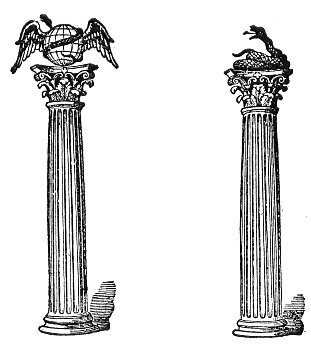The dragon and serpent are the 5th and 6th signs of the Chinese
p. 501
[paragraph continues] Zodiac; and the Hindus and Chinese believe that, at every eclipse, the sun or moon is seized by a huge serpent or dragon, the serpent Asootee of the Hindus, which enfolds the globe and the constellation Draco; to which also refers “the War in Heaven, when Michael and his Angels fought against the dragon.”
Sanchoniathon says that Taaut was the author of the worship of serpents among the Phœnicians. He “consecrated,” he says, “the species of dragons and serpents; and the Phœnicians and Egyptians followed him in this superstition.” He was “the first who made an image of Cœlus”; that is; who represented the Heavenly Hosts of Stars by visible symbols; and was probably the same as the Egyptian Thoth. On the Tyrian coins of the age of Alexander, serpents are represented in many positions and attitudes, coiled around trees, erect in front of altars, and crushed by the Syrian Hercules.
The seventh letter of the Egyptian alphabet, called Zeuta or Life, was sacred to Thoth, and was expressed by a serpent standing on his tail; and that Deity, the God of healing, like Æsculapius, to whom the serpent was consecrated, leans on a knotted stick around which coils a snake. The Isiac tablet, describing the Mysteries of Isis, is charged with serpents in every part, as her emblems. The Asp was specially dedicated to her, and is seen on the heads of her statues, on the bonnets of her priests, and on the tiaras of the Kings of Egypt. Serapis was sometimes represented with a human head and serpentine tail: and in one engraving two minor Gods are represented with him, one by a serpent with a bull’s head, and the other by a serpent with the radiated head of a lion.
On an ancient sacrificial vessel found in Denmark, having several compartments, a serpent is represented attacking a kneeling boy, pursuing him, retreating before him, appealed to beseechingly by him, and conversing with him. We are at once reminded of the Sun at the new year represented by a child sitting on a lotus, and of the relations of the Sun of Spring with the Autumnal Serpent, pursued by and pursuing him, and in conjunction with him. Other figures on this vessel belong to the Zodiac.
The base of the tripod of the Pythian Priestess was a triple-headed serpent of brass, whose body, folded in circles growing wider and wider toward the ground, formed a conical column, while the three heads, disposed triangularly, upheld the tripod
p. 502
of gold. A similar column was placed on a pillar in the Hippodrome at Constantinople, by the founder of that city; one of the heads of which is said to have been broken off by Mahomet the Second, by a blow with his iron mace.
The British God Hu was called “The Dragon–Ruler of the World,” and his car was drawn by serpents. His ministers were styled adders. A Druid in a poem of Taliessin says, “I am a Druid, I am an Architect, I am a Prophet, I am a Serpent (Gnadi).” The Car of the Goddess Ceridwen also was drawn by serpents.
In the elegy of Uther Pendragon, this passage occurs in a description of the religious rites of the Druids: “While the Sanctuary is earnestly invoking The Gliding King, before whom the Fair One retreats, upon the evil that covers the huge stones; whilst the Dragon moves round over the places which contain vessels of drink-offering, whilst the drink-offering is in the Golden Horns;” in which we readily discover the mystic and obscure allusion to the Autumnal Serpent pursuing the Sun along the circle of the Zodiac, to the celestial cup or crater, and the Golden horns of Virgil’s milk-white Bull; and, a line or two further on, we find the Priest imploring the victorious Beli, the Sun-God of the Babylonians.
With the serpent, in the Ancient Monuments, is very often found associated the Cross. The Serpent upon a Cross was an Egyptian Standard. It occurs repeatedly upon the Grand Stair-case of the Temple of Osiris at Philæ; and on the pyramid of Ghizeh are represented two kneeling figures erecting a Cross, on the top of which is a serpent erect. The Crux Ansata was a Cross with a coiled Serpent above it; and it is perhaps the most common of all emblems on the Egyptian Monuments, carried in the hand of almost every figure of a Deity or a Priest. It was, as we learn by the monuments, the form of the iron tether-pins, used for making fast to the ground the cords by which young animals were confined: and as used by shepherds, became a symbol of Royalty to the Shepherd Kings.

Moe is the founder of GnosticWarrior.com. He is a father, husband, author, martial arts black belt, and an expert in Gnosticism, the occult, and esotericism.






